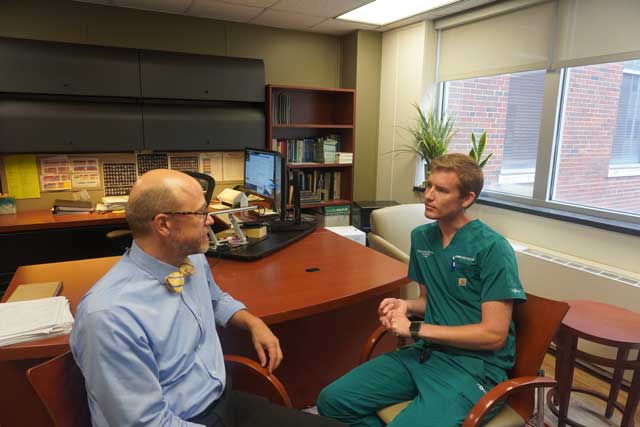The UAB School of Dentistry's Class of 2022 enjoyed a big slice of success regarding this year's new Integrated National Board Dental Examination.
 Dr. Ken Tilashalski (left) and Tanner GodfreyNot only did the cohort place among the top 10 percent of all dental schools that took the exam, but every single member of UAB’s class passed the test.
Dr. Ken Tilashalski (left) and Tanner GodfreyNot only did the cohort place among the top 10 percent of all dental schools that took the exam, but every single member of UAB’s class passed the test.
As a reward, the SOD threw what Class of 2022 president Tanner Godfrey calls “the biggest pizza party I’ve seen since I’ve been here.”
“When they announced that we’d all passed, there was definitely excitement across the board,” says Godfrey, who recently began an orthodontics residency at UAB.
Together, the new UAB SOD graduates scored better than 91.5 percent of all other dental school classes. Using a baseline of 0 – meaning half the dental schools did better and half did worse – the UAB SOD class received an overall score of 1.34, with scores in the 1.7 range for individual categories involving cellular and molecular bases, general and disease-specific pathology, and practice and profession.
“Our cohort absolutely hit it out of the park. Our scores were all overwhelmingly in the positive range,” says UAB SOD academic dean Ken Tilashalski, D.M.D. “What this means is we have a progressive, forward-thinking curriculum that positions our graduates to be successful.
“It’s also a reflection of the high clinical expectations for our students. This exam really integrates the biomedical and clinical sciences. And how we best prepare students for this is with a strong clinical program where they’re integrating these concepts with a hands-on approach day to day.”
For several decades, the National Board Dental Exam has been given in two parts. The first part focused on the biomedical sciences and was offered after the second year of dental school, then the second part focused on the clinical sciences and was given during the fourth year. But a few years ago, the American Dental Association decided to combine the two tests into one integrated exam to be given in the fourth year.
“The ADA gave us several years notice about this so schools could make potential curriculum changes to get ready for the exam, and we did make a few changes both in the administrative curriculum and on the faculty level,” Tilashalski says. “But we have had an integrated curriculum for more than a decade, so we were already very well positioned for this exam.
“They did a pilot exam a few years ago, and we had a group of students take it. Then we surveyed those students about if they were prepared and whether we needed to make any curriculum changes. They felt like our curriculum prepared them very well, so we didn’t make wholesale changes, just some tweaks.”
The key, Tilashalski says, is the UAB SOD’s emphasis on clinical sciences. He says the ADA informed schools that all the questions on the new exam would have some sort of clinical relevance to them, which has been a focus at UAB.
“One of the ways we prepare our students is to integrate the clinical sciences early in the curriculum and get the students in the clinic their first year,” Tilashalski says. “That helps promote the relevance of the biomedical sciences and medical history, and interacting with the patient and the behavioral sciences and how all that applies to dentistry.
“Two of the first courses our students take are Dentistry & Culture and Ethics in Dentistry. Because a dentist needs much more knowledge than just how to work on a tooth. A technician can fix a tooth. But it takes somebody with a greater skillset to be able to successfully treat a patient. A dentist needs to know the behavioral piece and the biomedical piece as well as the clinical piece, and our curriculum is staged to do all that.”
Godfrey says he was impressed with both the attention the UAB SOD faculty provided to get the students ready for the exam, as well as the way the students themselves banded together to be well-prepared as a group.
“The faculty was really supportive and worked to help us succeed. They made sure we had all of our resources and the time that we needed to study and prepare for it,” Godfrey says. “Then amongst the students there was good cooperation. It seemed like everyone was pulling together to make sure we’d all be successful on it, which turned out to be the case.”
Tilashalski gives much of the credit to the students. He says the zero-failure rate (compared to 2.5 percent nationally) is an indicator of the type of quality undergrads who are choosing to come to the UAB SOD.
“Our success really starts with recruiting highly skilled, really smart students,” Tilashalski says. “Our students are among the best in the nation. That makes our job easier as educators, because we’re starting with a really great group of motivated individuals from the start.”